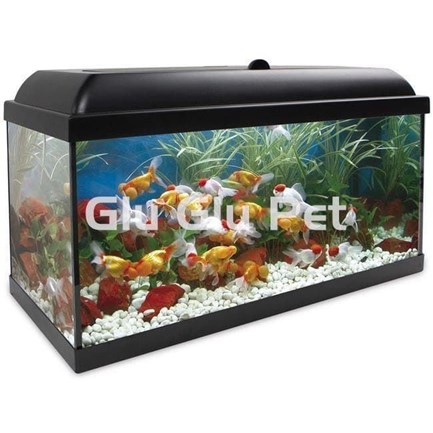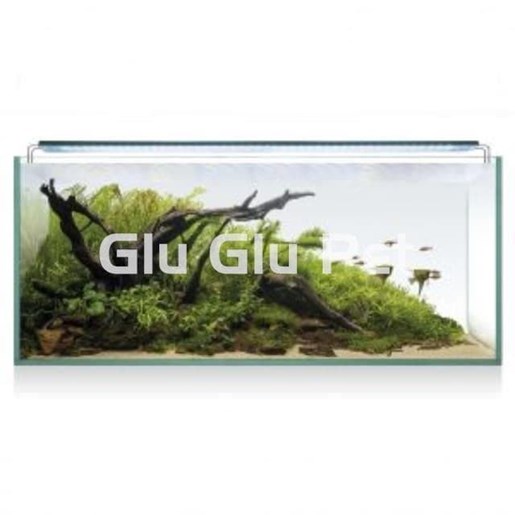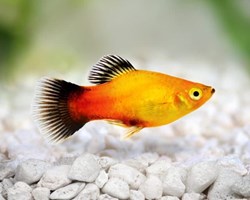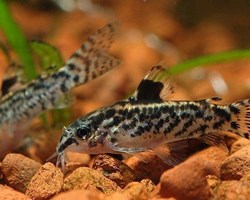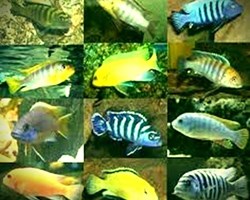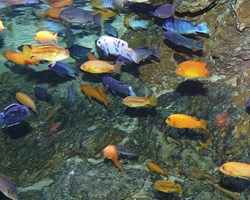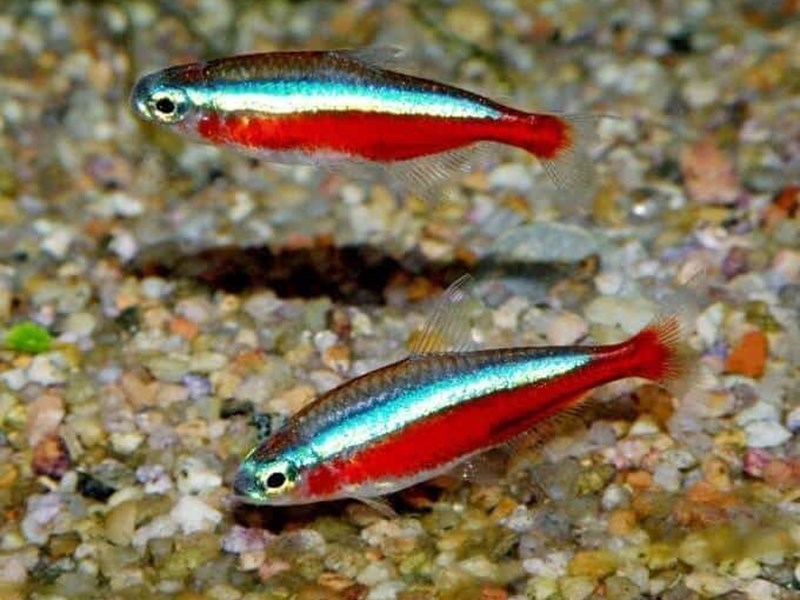
The Cardinal Tetra is the perfect beginner fish.
They are hardy, easy to care for and very colorful.
A group of them is great for displaying their vibrant colors, and their synchronized movements are almost hypnotic.
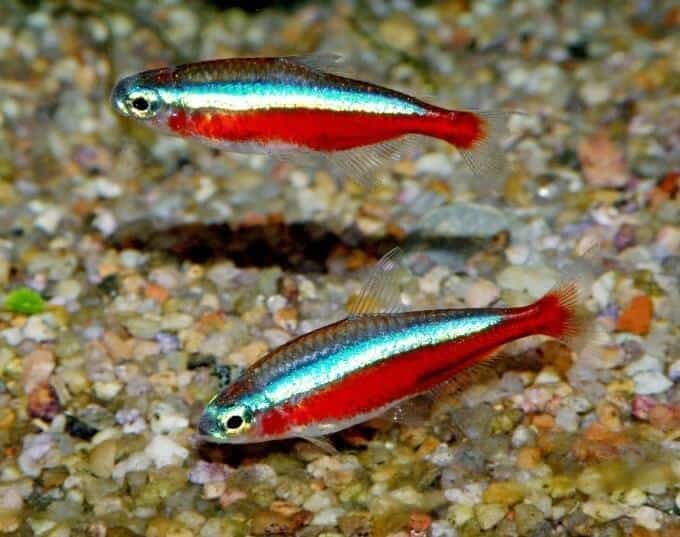
THE TETRA CARDINAL FISH:
The Cardinal Tetra (Paracheirodon axelrodi) is a social fish of the Characidae family.
They are sometimes called the Red Neon Tetra due to their similarity to the famous Neon Tetra.
These fish are native to the Orinoco and Negro rivers in South America.
This continent is home to many Tetra species, although some are found in Africa and Central America.
They are easy to incorporate into a community aquarium.
Even beginners can enjoy the color and activity they bring with them because they are hardy and enjoy a range of conditions.
In a clean aquarium, they can live up to five years.

BEHAVIOR OF THE TETRA CARDINAL FISH:
Cardinal tetras are a colorful schooling species that love to be kept in groups, the bigger the group the better (just make sure the tank is big enough).
They will swim together in the middle and upper levels of the aquarium.
They are much more trusting when around others of the same species.
If they are kept alone they will become stressed and shy, and will also lose some color.
They are easily intimidated by aggressive fish as they are unable to defend themselves.
Like most Tetras, they are peaceful and make a great addition to a community tank, but can also be kept in a species-only tank.
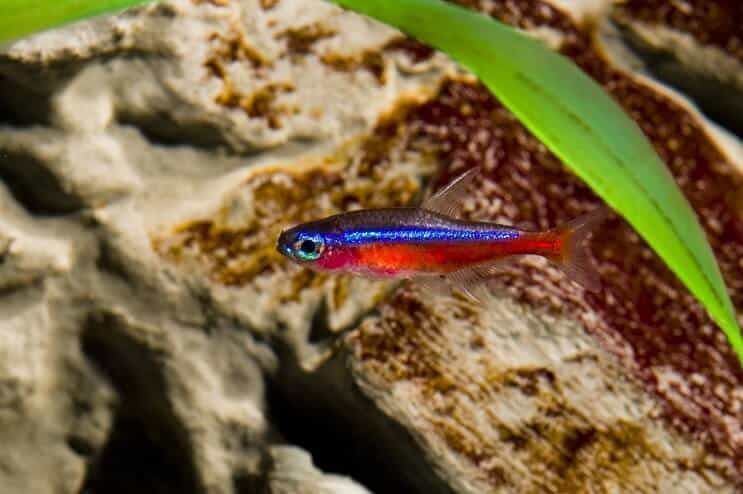
CARDINAL TETRA APPEARANCE:
This little fish only reaches 5 centimeters in length.
The main attraction of the Cardinal Tetra is its color.
Their fins are small and do not attract attention.
Their bodies are typically red and blue.
A red stripe runs down the bottom from head to tail, a blue stripe is just above it.
The colors are bright, so a school can be an eye-catching sight.
Evidence suggests that these species can also change their colors.
While red and blue is the most popular color, they can be found in golds and silvers (these are much less common).
It is very difficult to identify males from females because they have the same coloration.
Females can be identified if they are carrying eggs because they will have a rounded body.
It is not normally necessary to sex this species as they are kept in large groups, so there is likely to be a good mix of males and females.
Cardinal tetras live naturally in flooded forest areas, in shallow streams, and in the tributaries of large rivers in South America.
Although there are plants and rocks scattered around the bottom of the water column, there is plenty of open space for swimming.
The environment would be warm and slightly acidic, and the shallows move slowly.
Some areas get a lot of sunlight and others are very shaded.
Understanding the natural habitat of fish is great to help you set up the perfect aquarium for them.
AQUARIUM CONDITIONS FOR THE CARDINAL TETRA:
These fish do not venture to the bottom of the tank very often, so they can choose any substrate.
If you are starting a community with bottom dwellers, a sandy substrate is best because they are less likely to scratch.
It can be scattered around some decorations, but plants are ideal if you're trying to provide some shelter.
Your Cardinal Tetras will hide in them when stressed: Anubias Nana, Amazon Swords, and Java Moss are some easy species to care for.
You need to maintain proper water conditions.
Keep the temperature between 22-27ºC and the pH should be 6-7.
The filter outlet will create enough water movement and most standard aquarium lights are fine.
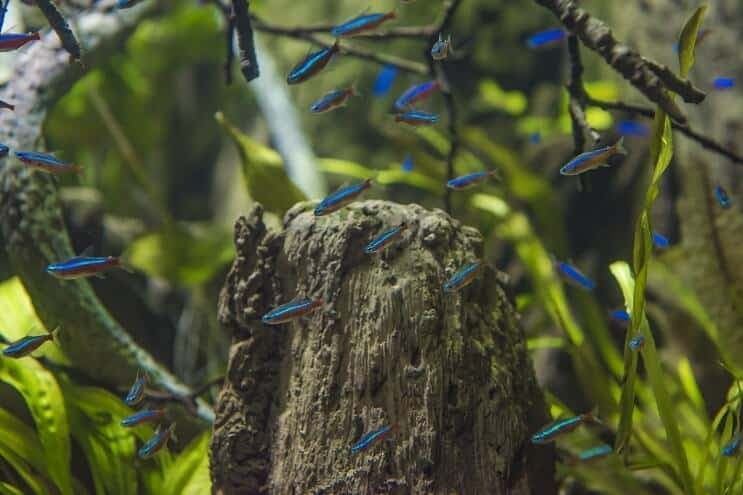
SUITABLE SIZE FOR CARDINAL TETRA AQUARIUM:
Although cardinal tetras are small, they tend to live in large groups, so you need an aquarium that can accommodate a group of at least six.
A 75 liter aquarium will provide enough swimming space to meet your active lifestyle.
7 liters for each additional Tetra is fine.
AQUARIUM SETUP FOR THE CARDINAL TETRA:
SUBSTRATUM:
Cardinal tetras live in a blackwater river environment.
Add a bag of aquarium-grade peat moss to the filter and sprinkle some dry leaves over the substrate to help create black water.
The best substrate to use is dark river sand, which looks natural and helps show off the bright colors of the fish.
DECOR:
Your tank decor can continue the natural-looking theme with rocks, twisted roots, water-smoothed stones, and driftwood.
Make sure your aquascape provides plenty of open water for swimming and studying.
There aren't many plants in the Cardinal River house, largely because the lighting is so poor.
You may want to include some specialized low-light plants for aesthetic reasons and to give the fish some hiding places to seek out if they choose.
Floating plants are ideal for this type of setup as they help diffuse light and provide shelter for fish.
HOW TO SET UP YOUR AQUARIUM:
- Rinse the dust from the river sand under running water.
- Put two to three inches of sand in your aquarium.
- Plug in the heater and filter, but do not turn them on yet.
- Add non-chlorinated tap water to the tank, pouring the water over the dish or container upside down so the sand doesn't dislodge.
- Wash the dust off your decoration and place the items in the aquarium as you like.
- If you have decided to include live plants in your aquascape, you will need to prepare them by cutting off dead leaves and damaged stems. Add the plants to the configuration.
- Turn on the aquarium heater and filtration system.
- Live plants need eight to ten hours of light a day to photosynthesize, so set the timer on your lighting unit to accommodate that.
TETRA CARDINAL FISH COMPATIBILITY:
This peaceful species is suitable for community aquariums.
They stick to their own schools and generally ignore anything else in the tank.
They can be kept with most other peaceful fish.
Aggressive or territorial species will intimidate your Cardinal Tetra, stressing them to the point of death, an example of this is the Rainbow Shark.
Large fish should also be avoided as the Cardinal Tetra is small and easily eaten by those with large mouths.
Some good tank mates include:
- Neon tetras.
- Zebra Danios.
- Ax Fish.
- Mollies.
- Dwarf Gourami.
- Angel fish .
- guppies.
- Zebra Loaches.
- Yoyo Loaches.
- Otocinclus work well if you are looking for occupants in the lower regions of your aquarium.
- Cherry Shrimp
- Mystery Snails are also compatible and are a great way to diversify behaviors in your aquarium.
- Tetra black skirt.
- Ember Tetra.
- Chili Rasbora.
- hatchet fish
- neon green tetra
- Mollies.
- Harlequin Rasbora.
- Emperor Tetra.
- Small types of aquarium catfish
You should definitely keep Cardinal Tetra in groups.
They need to be in groups of at least six to bring out their natural behaviors.
The larger the school, the happier they will be.
CARDINAL TETRA NUTRITION:
The Cardinal Tetra is omnivorous, and will eat pretty much anything you put in its tank.
There are many types of fish food available, and each has its pros and cons.
It is generally best to mix a few types into the fish's diet to ensure they receive a balanced diet.
Dry foods are the easiest to get.
Live and frozen foods are packed with nutrients, so use them to supplement the rest of your diet.
You can also add green vegetables to the aquarium. This varies the diet and helps prevent food waste. Chop them up and only give them small amounts.
Feed the adults twice a day, giving them what they can easily finish in two minutes.
If there is any food left over, remove it before it breaks down in the water.
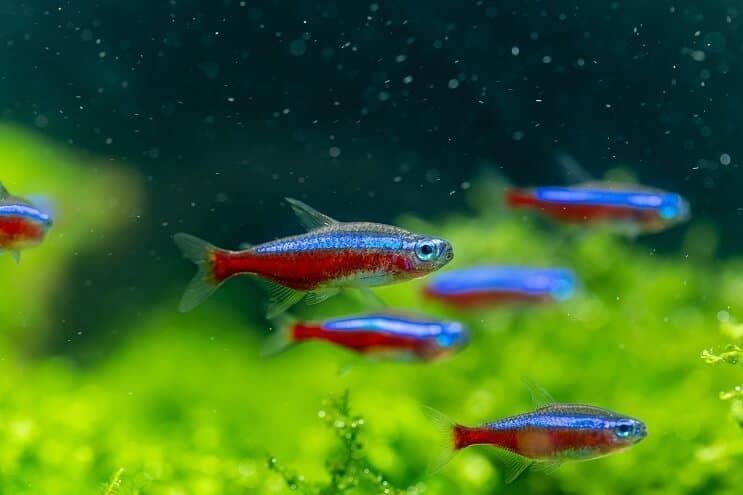
CARDINAL TETRA CARE:
The Cardinal Tetra is an easy fish to care for.
It is not very demanding and can tolerate a number of water conditions and configurations.
They can get sick like all aquarium fish.
One of the most important parts of caring for them is choosing the right diet.
If your Cardinal Tetras don't get the nutrients they need, then they will lose their color and their immune system will be weakened.
Another thing that can weaken the immune system is a sudden change in environmental conditions.
These fish cannot survive a drop in temperature for very long.
Not only must the parameters remain stable, but the aquarium must be kept clean.
Regular water changes prevent the buildup of contaminants.
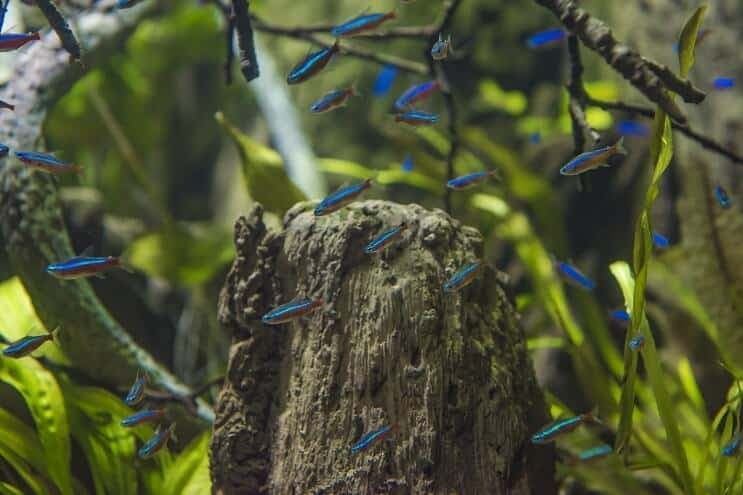
HOW TO RAISE CARDINAL TETRA FISH:
Cardinal tetras will naturally breed upstream in shaded regions.
The good news is that they can be raised at home, they just need quality conditions that replicate their natural breeding environment.
Begin by turning off the aquarium lights.
You need to be on top of the cleanliness of your aquarium, weekly water changes are important for this.
The parameters must remain stable and you cannot let contaminants or algae build up.
A nutritional diet is also important to get your fish ready to mate.
A female will have a rounder body when she is ready because she will be carrying the eggs.
She will let a male swim alongside her as they move through the plants. They will then release the sperm and eggs.
The eggs should hatch after three days.
The fry will be too small to eat an adult diet, so feed them small foods such as infusoria until they are large enough.
The hatchlings will be photosensitive once hatched, so they will gradually increase the light intensity to return to normal conditions.
After 8 to 12 weeks, they should have colors that correspond to those of adults.
POTENTIAL DISEASES OF TETRA CARDINAL FISH:
There are a few different diseases that you need to watch out for.
These fish are susceptible to common freshwater problems such as Ich, dropsy, and fin rot.
The good news is that these diseases are easy to treat with some over-the-counter medications.
Do regular water changes and use test kits to analyze the chemistry of the water.
Make sure your filtration system is also in good working order to prevent ammonia and nitrate levels from getting out of whack.
A unique health issue to watch out for is:
THE NEON TETRA DISEASE:
Despite its name, this disease affects a wide range of different types of tetras.
It is a parasitic disease that is often carried into tanks through other infected fish or infected live food.
The disease causes spinal problems, cysts, and many other health problems.
Unfortunately, there is no known cure for it.
ICH OR WHITE SPOT DISEASE:
Ich is also called white spot disease and is caused by a parasite.
Infected fish have a rash of small white spots on their bodies, fins, and gills, and are usually bumped or rubbed against objects in the tank.
Raise tank temperature to 82º for three days.
FLUKES:
Flukes is a general term that describes various species of external fish parasites.
You may see flukes or worms attached to the body or gills of the fish.
Treat the aquarium with an antiparasitic drug.
FUNGAL INFECTIONS:
White, fluffy growths on the fish's mouth, head, and body.
Quarantine infected fish.
Treat with a fungal medication at Glu Glu Pet.
BACTERIAL INFECTIONS:
Torn and bloody fins.
Red spots, sores, ulcers on the body.
Treat the aquarium with an antibacterial treatment.
You also have to clean up excess algae before they can cause problems.
One disease to watch out for in the aquarium is Neon Tetra Disease, which affects many Tetra species.
It is caused by a parasite and causes symptoms such as discoloration, cysts, a curved spine, and secondary infections.
It normally enters the aquarium when fish that are not in quarantine are added or fed infected live food.
There is no known cure for this disease, most infected fish are euthanized.
They are removed from the aquarium as quickly as possible so that they are not eaten and do not infect other fish.
- eSHa 2000 (Treatment against fungi, prodrid fins and bacteria).
- TETRA FUNGI STOP (Fungi treatment).
- TETRA GENERAL TONIC PLUS (General treatment and fin rot).
Other diseases you may experience are fin rot, ich, and bloat. These are better known and much easier to treat.
Other articles that may interest you:
Some Glu Glu Pet products that might interest you:
- TETRAMIN.
- 100 l aqualed aquarium kit with Optimus filter (ICA).
- AQUASCAPE RGB 100 Kit (100 l) (ICA).
- AQUASCAPE RGB 130 kit (123 l).
- External or cup filter: EHEIM CLASSIC 150 / 2211.
- External or glass filter: EHEIM PROFESSIONAL 4 250.
- External or glass filter: Fluval 207 External Filter.
- External or glass filter: JBL Cristal profi e402.
- Lighting: BLAU MINI LUMINA fresh water.
- Lighting: COB 3W white/blue LED lamp (ICA).
- ROCK DRAGON.
- HOLESTONE ROCKS SET.
